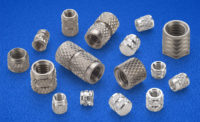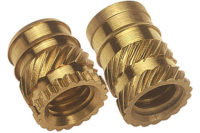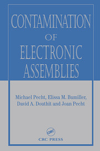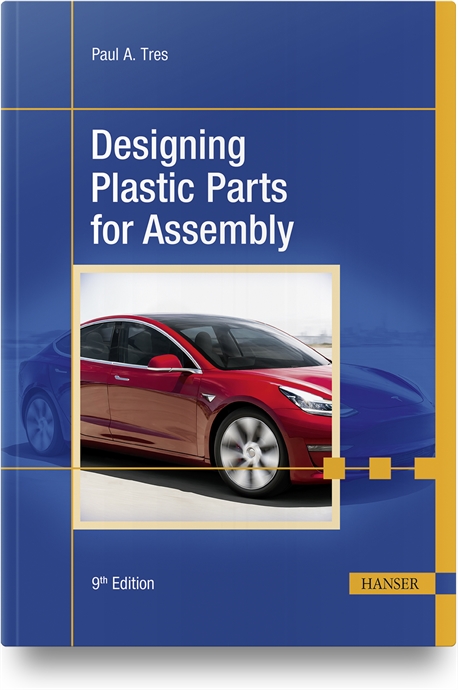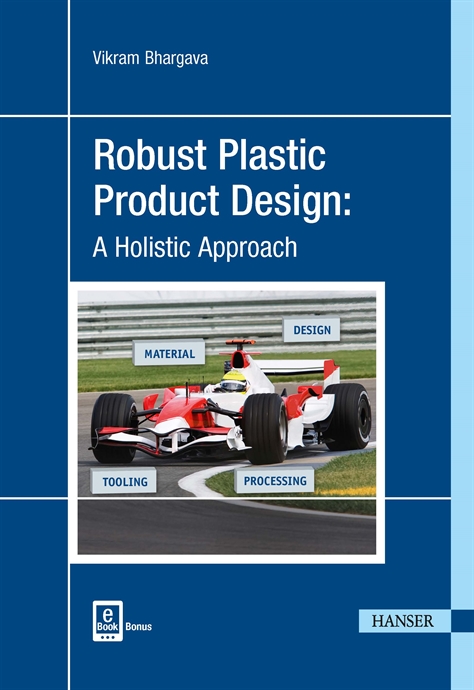In many ways threaded metal inserts in plastic provide the best of all possible worlds. On the one hand, you have the ease and flexibility of plastic construction. On the other, parts can be safely and securely fastened using machine screws, which means they can also be easily disassembled.
This can be especially valuable in applications like plastic housings for electrical components. In the event these products require maintenance, the housing can be removed or opened without damaging the housing itself. In contrast, when fastening with screws driven directly into plastic there is the danger of creating crossed or stripped threads every time the parts are rejoined. Because of this utility, threaded inserts can be found in everything from appliances to automobiles and toys, as well as in furniture, computer, aerospace, medical and defense applications.
Another advantage to threaded inserts is that they create stronger assemblies by spreading loads over a larger area, especially when used in materials like softer thermoplastics. When correctly installed-generally in a boss-inserts provide roughly twice the clamping strength than screws driven directly into plastic.
On the downside inserts represent an expense. They cost money to buy and install. They can also be difficult and expensive to remove in the event a defective part must be disassembled for recycling. It is for these reasons that the elimination of fasteners in general-not just inserts-is a major trend in assembly today. Nonetheless, as plastics take the place of more and more metal components, the overall insert market continues to grow.
In terms of different installations, in nearly every case inserts require a predrilled or premolded hole in which they can be installed. After that they can be secured either mechanically, or through the use of heat or ultrasonic welding.
Mold Them In
The one instance in which no drilling is required is when inserts are individually placed in their designated locations in a mold before the plastic part is created. The inserts are secured on pins, and when the plastic fills the mold cavity the melt runs into the recesses of the insert, locking it into the part as the plastic cools. This technique provides high levels of torsional and tensile stress resistance. However, molded-in inserts are far from ideal from a production standpoint.For one thing, they can be expensive because the molding cycle has to be extended to permit loading the inserts. This is often done by hand, although in some cases robots are used. Beyond that, in the event something goes wrong, parts with missing inserts must also be rejected or reworked-another expense. In addition, inserts that break loose during the molding process can damage molds, and insert threads may become clogged with flash.
Still, the molding technique works well when strength is important; molded-in inserts are built with aggressive diamond-knurl patterns and deep undercuts that enable them to get a strong grip on the surrounding plastic. Strong hexagonal configurations may also be used to provide torsional strength.
As is the case with nearly all inserts, molded-in inserts are predominantly fabricated from brass-by some estimates up to 90 or 95 percent. This is because brass is relatively inexpensive, easy to machine and provides more than sufficient strength. Stock inserts are also available in aluminum and stainless steel, but these are more expensive and only used in special cases. Stainless steel, for example, is often used in medical or food-service applications where corrosion resistance is at a premium. It may also be used for outdoor applications, again because of its resistance to corrosion. Aluminum, in addition to resisting corrosion, serves as the insert of choice when weight is a factor.
In terms of strength, stainless steel is stronger than brass and aluminum. However, in all three cases the insert itself will generally be stronger than the surrounding material.
Similar in terms of performance to molded-in inserts are those emplaced using a thermal press or ultrasonic welder. Both techniques provide a secure anchor for the inserts because they melt the surrounding plastic, allowing it to flow in around the grooves, ridges and undercuts in the exterior wall of the insert. Because only a small portion of plastic is melted the attachment is not quite as strong-microscopic gaps between the plastic and insert mean slightly less bond strength. But performance is still comparable, and ease of emplacement is making them increasingly popular.
In fact, these technologies have largely displaced the practice of molding in inserts. Jim Haste, sales and engineering manager for Tri-Star Industries Inc., estimates that 70 percent of his customers' applications involve thermal or ultrasonic emplacement. Mike Knipple, a product manager for Emhart Teknologies' Dodge line of inserts, says heat-staking emplacement represents 45 percent of his customers' applications; ultrasonic emplacements constitute 35 to 40 percent; and only about 5 percent of the inserts that his company sells are molded in.
By contrast, Yardley Products Corp. president Jack DeHaven says that molded-in inserts still represent about half his company's insert business. But ultrasonics and thermal emplacement make up the bulk of the remainder.
The main limitation to ultrasonic and thermal emplacements is that, while they work well with thermoplastics, they do not work with thermosets. Otherwise, the two processes work well for everything from low to moderate to high production runs and offer short cycle times.
Drive With Sound
Ultrasonic welding in particular makes for short cycle times: less than half a second for smaller pieces. The emplacements are very consistent, and the technique easily lends itself to either partial or complete automation. Semiautomated systems often include two separate stations: one in which the inserts are manually placed in their holes, and a second where the press drives them home. In fully automated systems, the inserts can be fed via feeder bowl or carrier tape, with the latter being less common. The parts can be cycled through by indexing conveyor or turntable.Ultrasonic inserts are designed to partially enter the predrilled hole with the help of a smooth "pilot" section. The vibrating ultrasonic horn then causes the textured part of the insert to travel the rest of the way in. The heat generated by the vibration melts the plastic, molding it to the insert and locking it in place.
In terms of their surface patterns, ultrasonic inserts usually come with moderate hooks, undercuts and angled or "helical" knurls. These allow the insert to enter the hole with a minimum of force but still hang on once the melted plastic has cooled. Ultrasonic inserts generally do not have the aggressive diamond patterns found on some molded-in inserts-patterns that can cause undue stress during emplacement, possibly cracking the boss.
When placing inserts ultrasonically, it's important that the insertion speed coincides with the melt velocity to ensure there is a secure emplacement. Dukane Corp. marketing manager Mike Johnston says he's seen cases in which manufacturers have tried to bump up throughputs, with the result that yields decline due to weak pull-out strength and even cracked bosses.
"It's critical that the velocity that you drive the insert into the boss matches the melt-flow velocity," Johnston says.
With regard to its drawbacks, ultrasonic welding is limited by the fact that presses can emplace no more than four or five inserts at a time; the placements must be fairly close together, no more than 6 inches apart; and the inserts must be in roughly the same plane, with a height difference of no greater than half an inch. The ultrasonic welding process is also a noisy one, especially when placing inserts larger than 1/4 inch in diameter. In fact, much larger and ultrasonic emplacement does not work anyway; the physical mass of the part is such that is doesn't allow sufficient heat generation.
Johnston notes that one way around these limitations is to use an X-Y table to move the part while a programmed press makes the various emplacements. But of course, this takes more time.
Drive With Heat
With thermal emplacements, on the other hand, the sky's the limit in terms of the number and orientation of the emplacements. "You can pretty much accommodate all different heights and geometries because you are not limited by the acoustical design of the tool," Johnston says.Knipple says he had one customer that was installing 64 inserts at a time as part of a semiautomated two-step process. An operator would place the inserts and then position the part in the thermal press for emplacement. While this was being done the operator would begin placing the inserts in the next part.
In many ways, thermal installation is similar to ultrasonic installation. In fact, the process uses the same style of inserts. The design of the predrilled holes is also the same: slightly deeper than the insert to provide room for excess melted plastic as the insert is placed, and just slightly narrower than the width of the insert. If the hole is too shallow, excess melted plastic can flow back up into the open end of the insert, clogging the threads. If the hole is too wide there will be insufficient interaction between the insert and the surrounding plastic; too narrow and there is the danger of cracking the plastic, or causing excess plastic to flow over the top of the insert during installation. Some inserts are built with a flange to prevent plastic from flowing into their threads. Others are "blind," with closed ends to prevent plastic from clogging threads. Having a too-narrow predrilled hole also slows down the insertion process, resulting in excessive cycle times.
Other advantages to thermal installation include the fact that thermal presses are much quieter than their ultrasonic counterparts, as well as less expensive, around 10 to 20 percent cheaper according to Johnston.
As is the case with ultrasonic emplacement, it's important that insertion speeds do not get ahead of melt flow rates in order to avoid poor mating between the inserts and the plastic, degradation of the surrounding plastic and cracked bosses.
Self-tapping and Press-ins
Generally less rugged in terms of torque and pull-out strength are post-molded, threaded inserts that are emplaced mechanically. These include self-tapping inserts, press-ins, and expansion or spreader-plate inserts. They can all be used with both thermoplastic components and thermosets. The category also includes helicals, which are somewhat different from the rest of the group.Conventional helical inserts are driven into a pretapped hole by means of a wire tang. When twisted in with a special tool-either manual or automatic-the force applied by the tool reduces the diameter of the coil allowing it to enter the hole more easily. Once installed, the tool is removed and the coil resumes its original shape. The resulting outward force creates friction against the threads in the plastic, which holds the coil in place. Once the tang is broken off at a pre-notched point on the coil the insert is ready for use.
Compared to other mechanically installed inserts, helical inserts, which are fabricated from stainless steel, provide high tensile and torsional strengths, thanks to the interaction between the coil and the threaded wall of the hole. However, they are expensive to install because the insertion operation is relatively slow. The need for a tapped hole also increases production time.
On the plus side, they offer very precise threads for demanding applications in the medical and aerospace industries. Automated systems are also available to speed up emplacement. Emhart Teknologies, for example, offers a One Step Automation Tool that both emplaces its proprietary HeliCoil insert and breaks off the tang. As part of the process the company uses a tape feed system to help place the individual parts. The machine can stand alone or be incorporated in most assembly lines. Still, helicals represent a small fraction of the total insert market.
By contrast, self-tapping inserts are installed in smooth-walled holes. They can be emplaced manually or automatically. Basically, the hole is sized to fit the insert and the insert is driven in place. The inserts are available in both thread-forming and thread-cutting varieties, with thread formers working well with soft plastics, and thread cutters serving in harder plastics. Self-tapping inserts are often the post-molded insert of choice because they can be used in a wide range of plastics, including both thermoplastics and thermosets, and even wood.
On the downside, self-tapping inserts, although offering a strong attachment, are time consuming to emplace, resulting in long cycle times. Knipple estimates that self-tapping inserts require cycle times two to three times longer than other insert styles, although they offer good tensile and torsional performance. For smaller runs, or even prototypes, insert manufacturer Yardley Products Corp. markets both a handheld and a bench-mounted pneumatic inserter. The bench model can emplace as many as 800 self-tapping inserts in an hour.
Easier to install, but weaker, are expansion inserts, in which driving the screw into the insert generates a radially outward force that presses the wall of the insert against the inner surface of the predrilled hole. Expansion inserts include various barbs, knurls or flanges that are pressed into the plastic. Because they are simply pressed into the predrilled hole they are quick to install and lend themselves to automatic installation, at rates as high as 60 parts per minute.
These types are easily identified by slots running lengthwise for part of the barrel and an aggressively textured outer surface, often in a diamond pattern.
The easiest inserts to install are simple pressed-in inserts. These are fabricated with various rings, hooks or angled threads and can be emplaced in cold plastic or shortly after molding when the plastic is still warm and pliable. PennEngineering has also recently introduced what it calls its DeltaForm line. This consists of stamped brass inserts-as opposed to machined-that can be pressed in to form reusable threads at low cost. PennEngineering claims they are half of the cost of conventional inserts while still providing twice the torque performance of a screw driven directly into plastic.
Pressed-in inserts provide the shortest cycle times, and can be installed with a hand press or a fully automated process. On the downside, the anchor is not as strong as a threaded, or heat- or ultrasound-installed insert. Also, this emplacement technique places the most stress on the surrounding plastic, which requires beefier bosses, and there is little room for error in terms of the size of the predrilled hole.
In some cases the inserts can be secured with adhesive. However, there is the danger of excess clogging the inner threads of the inserts, rendering them less effective. It is also important to ensure that both the insert and the wall of predrilled hole are sufficiently clean to ensure adequate bonding.
On the plus side, the resulting insertion can be a strong one-nearly as strong as with a thermal or ultrasonically placed part.
